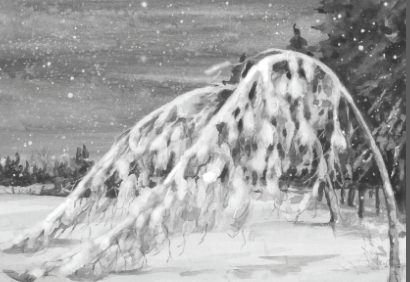By Rebecca Perkins Hanissiant
Of all life’s synergies, I appreciate most the one between my propensity for domestic procrastination and my love of moving through the outdoors — countless adventures are born of it. During a late November weekend, when faced with a day spent winterizing our home, my husband and I instead packed up our children and headed for Mount Moosilauke. Ascending the Gorge Brook Trail, we moved quickly, our son pouncing on every puddle, delighting in the power of his 60 pounds to break through the creme brulee-layer of ice.
With this thin ice and a dusting of snow, the lower elevations had been warned of winter’s approach. The higher elevations, we soon discovered, were being blasted by its arrival — every surface, be it branch, rock, or summit signpost — was coated in a substance equal parts snow and ice. The wind, roaring and sustained, stung our noses and cheeks, the only bits of skin exposed.
Despite this harbinger of winter storms to come, it appeared the trees were simply standing around. But looks can be deceiving. While I may have been procrastinating on winter preparations, the trees were busily, if subtly, bracing themselves for the snow, ice, wind, and frigid temperatures. They’ve been doing so for months, for millennia.
In handling heavy snow and ice loads — infamous for breaking branches and bending trunks — our northern tree species vary in strategy. The high-surface-area leaves that increase a deciduous tree’s photosynthetic capacity in the warmer months become load liabilities in the winter, offering ample parking for heavy snow and ice — and surfaces for catching the wind. For this and other reasons, these species drop their leaves in autumn. These hardwoods rely on branch architecture and strength to support the snow and ice that settle on them. Species such as maples, birches, and ash trees, all long-term residents of the northern forests, drop their leaves quickly in the fall. On the other hand, oaks and beeches — relative newcomers with tropical origins — often, and at their own expense, sport crinkly brown leaves well into winter.
Employing a different tactic, coniferous species, including spruce and fir, hold on to their low-surface-area needles year-round. Their flexible branches bend with the weight of snow, like Christmas tree boughs adorned with too-heavy ornaments. But as the branches droop, the snow slides off, and the branches spring defiantly back to shape. Ice proves harder to shrug off and can cause branches to break, bark to tear, and trunks to bend.

That flexibility serves coniferous trees well with regard to winter winds, too. Flexing with the wind dissipates the wind’s kinetic energy, thereby reducing force on individual branches and the tree as a whole. This streamlining proves more difficult for deciduous trees with stiff branches, even after they have dropped their large leaves.
Frosted and asymmetrical, the crowns of the exclusively coniferous trees near the summit called to mind white sails whipped taut, betraying the wind’s direction. But unlike sails adjusted to capture the wind’s energy, these crowns are aerodynamic, shaped by the prevailing wind to evade as much of its energy as possible.
To cope with freezing temperatures, coniferous and deciduous trees alike are triggered by longer nights and cooler temperatures to progress to a state of dormancy and maximum cold tolerance by mid-winter. Insulation by dead cells, which constitute 99% of a mature tree’s woody volume, and a number of seasonal cellular changes, help to prevent live cells from freezing. According researchers at Purdue University’s department of forestry and natural resources, these cellular changes include a transition to more pliable cell membranes that can withstand the sharp edges of ice crystals that form when the water between cells freezes. Within each cell, starch is converted to sugars, which will serve as antifreeze, lowering the cell’s freezing point. Then, as water leaves the cell through its more pliable membrane and as the content of the cell thickens and cools, viscosity increases, preventing crystallization, which can shred cell membranes.
Eight miles and four hours after beginning our hike, my family returned to our car and then our home, which was exactly as we’d left it: unprepared for winter. Eventually, we did weatherstrip the windows where the wind whistled through, shoring up our house’s membrane. But our late attention to winter’s arrival put us in the company of the procrastinating oak, shamed by the proactive ash.
Rebecca Perkins Hanissian is the editorial and outreach coordinator at the Center for Northern Woodlands Education. Illustration by Adelaide Murphy Tyrol. The Outside Story is assigned and edited by Northern Woodlands magazine and sponsored by the Wellborn Ecology Fund of the New Hampshire Charitable Foundation: nhcf.org.




